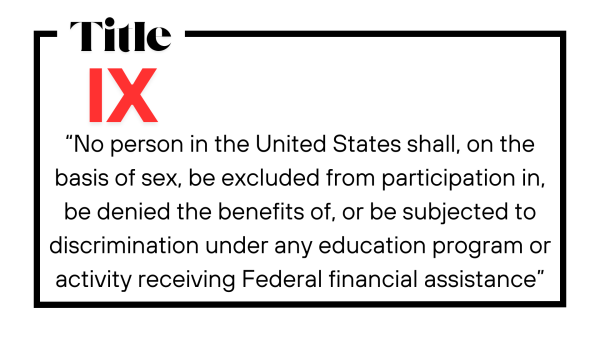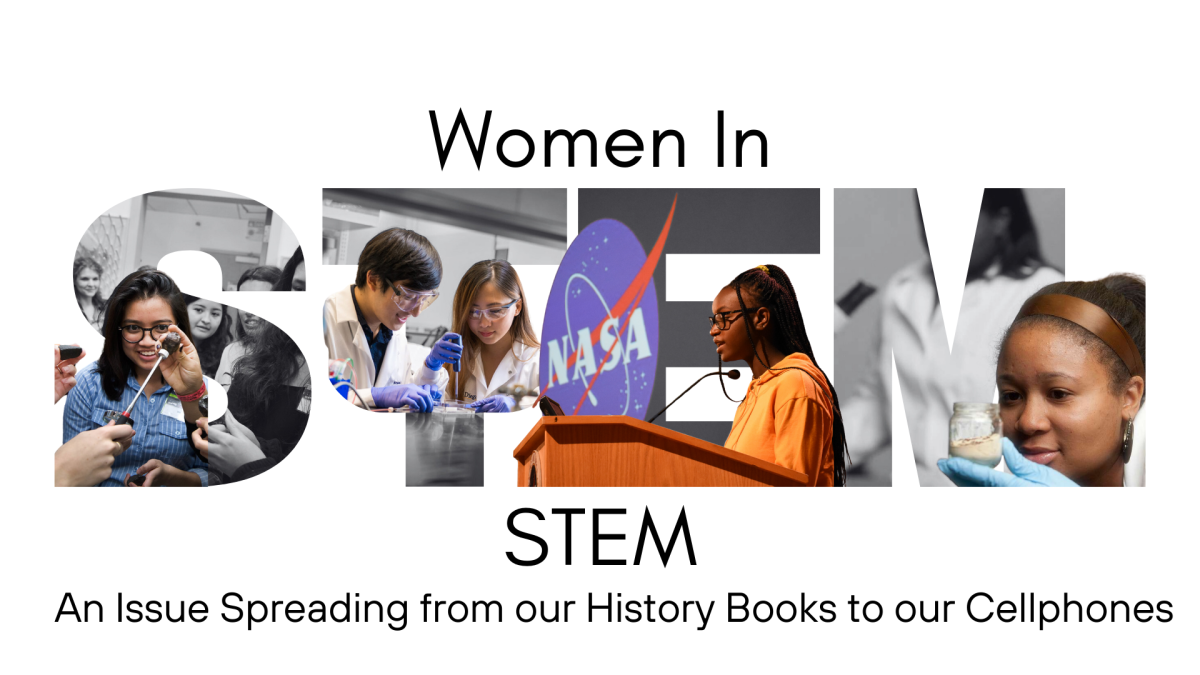It’s not all men who are to blame, but the under-representation of women in STEM is the result of male-dominated systems that have historically excluded or overlooked women’s contributions. Due to these decades of exclusions, women have struggled to make equal contributions to science, technology, engineering, and mathematics (STEM) as men. Supportive policies like

Title IX, which addresses gender bias in education or other federally assisted programs, has made discrimination during education easier to overcome. Despite attempts at rendering systematic issues via policy, it hasn’t halted prejudice from classmates. What’s concerning is that a growing minority of men who bully in classrooms or at science fairs have begun spreading to other platforms, including media. Misogynistic comments by men on the internet have thrown efforts to advance women in STEM into retrogress.
Current Discrimination

The media has become a catalyst for discrimination towards women in STEM. For example, an internet user, by the name Lusha_jiang, commented on a post supporting the privilege it is to work in STEM. They stated, “It’s [STEM] hard, but why can’t girls do better in science courses? Of course girls can do better.” While a seemingly innocent comment to many upon closer look it’s clear it’s rooted in misogyny. The comment emphasizes hidden misogyny in many’s belief that women, unlike men, should be working harder or that women aren’t doing enough to help themselves.
Moreover, on a post about Margaret Hamilton, men left comments that diminish women entirely. Margaret Hamilton, NASA’s lead software engineer for the Apollo program, hand wrote such an immense volume of code that, when printed and stacked, it stood as tall as she did. It’s seen as a powerful visual testament to her pivotal role in getting the U.S. to the moon. Men left thousands of hateful comments, but here are just a few: “It’s good she knew her place and let the men take over in the end when it came down to the real work.” Another user, slavic_historian, commented, “Pretty sure that’s just her plan of how to record fake moon landings.” When someone tried to respond to the user’s comment, they replied, “Maybe if we let smart people, MEN, in charge of code, I’d be certain we went to the moon.” That reply has since been taken down, presumably by the media platform.
Alternatively, people with larger influence seem more comfortable targeting women publicly. The now infamous comment by Kansas City Chiefs’ kicker Harrison Butker to a group of liberal arts students directly targeted working women. He said to the audience of women that rather than looking forward to their jobs, they should look forward to the kids they will have and the men they will marry. Many women at this school studied liberal arts science and took Butker’s comment to mean women specifically shouldn’t be in a “man’s job,” like science. While Butker and others’ comments are drastically more targeted than Jiang’s, it is clear they’re singing the same tune with different words. Made evident by their preposterous remarks and many more found across the internet, it is clear many men are stepping back from STEM equality, and despite major contributions from women in STEM, persistent cultural, institutional, and media-driven biases continue to undermine women’s progress and recognition.
Historical Discrimination
To understand the biases of today, we must look at where they take root. Every bias starts somewhere, and once they start, they’ll likely never go away.
For example, current racial stereotypes in the U.S. take a lot of their roots from the era of segregation. STEM biases, on the other hand, take a lot of root in male praise. We live in a constant cycle of praise towards men in STEM because men’s STEM contributes directly to technological and scientific progress, which drives economic growth. It is plausible phenomena of praising STEM and degrading women in the field is linked to the Scientific Revolution; this is when the most influential scientists, like Galileo and Isaac Newton, began to change the way we perceive the world. With their achievements, we began to see scientific innovation as the sole tie to economic growth. While their achievements should not be belittled, we must understand the few consequences that arose from this. When STEM was created, it drew a lot of attention to the highest in society, men. This resulted in high recognition for scientists like Einstein, Bohr, Galileo, and Darwin. For example, while Galileo gained fame in Europe in 1610, women would not get any significant representation in STEM until the 1970s. That is 360 years after Galileo and 52 years after most women entered the workforce.

This is not to say that before the 1970s no women pursued STEM; in fact, many of the most notable female scientists came before the ’70s. Consider Marie Curie; she was a driving force in the discovery of radium and polonium, more so than any of her male counterparts. Though outside of her peers, it was entirely unheard of to applaud a woman for such a discovery. As a result, she shared the Nobel Prize with Pierre Curie and Henri Becquerel, who contributed as well but far less. If she were to make this discovery today, she would’ve had a better chance of getting her own prize, as modern Nobel committees support individuals who led the discovery, not trying to skew the achievement to favor men.

Following Curie is Lise Meitner. Meitner is the predominant scientist responsible for our understanding of nuclear fission. However, her collaborator, Otto Hahn, who was not responsible for her work won the Nobel Prize instead. Afterwards, men largely took over research with nuclear science, partially as a result of Hahn winning the Nobel Prize instead of Meitner. Despite Meitner now being recognized for her achievements, today we still face the consequences of her under representation, with over 83% of the nuclear engineering jobs being occupied by men (Townsend, et al 2022).
Other more recent figures include Grace Hopper, a big lead in computer science, and Sally Ride, the first American woman to go to space. These women made most of their contributions from 1940 to 1980 (Grace Hopper) and 1983 (Sally Ride). These women are key examples of how women’s achievements are singled out among the greater body of women in STEM.
When Grace Hopper was working in computer science, there was a shift in women in computer science. At the beginning of her career during the 1940s, many women were involved in computer science by programming early computers like ENIAC. However, as time passed, women in computer science dropped starkly, with 37% of computer scientists in the 1980s being women (“Changing the Curve: Women in Computing – I School Online” 2021).
Comparatively, when Sally Ride became an astronaut, six other American women worked in the field as well as two women from the Soviet Union. Still, Sally Ride is often falsely credited by the uniformed public as the first woman in space when really that achievement belongs to the Soviet Union. Alternatively, Ride is the only woman from the ’80s credited with helping advancements in space but based on her six female colleagues this simply isn’t fair.
The situations of Hopper and Ride highlight that while women may be allowed into STEM fields, they get treated differently from men. Women’s achievements become singled out from female scientists, whereas men’s achievements often get attributed to the work all men in the field do. This tends to overshadow women’s achievements, as they are quickly forgotten, but those remembered for their achievements are labeled as an abnormality and therefore get treated as a solitary achievement.

This situation has evolved today with women’s performance in space and computer science often being overshadowed by men like Elon Musk, who have in truth made no achievements, if not for the work of others. This leaves men with the most acknowledgments, and women only have the work of women in the past to celebrate.
To elaborate, Musk is not actually responsible for many of the things he’s known for, like Tesla, which is not his creation; he just bought out the company. Additionally, SpaceX is built on the work of his team, not him. He’s a businessman, not an engineer. Yet prior to recent controversy, we seem to paint him as a technological genius.
In contrast, women who are actually involved in science and making progress, like in astronomy, are cast aside by men, leaving only the select few women like Sally Ride as the face of females in STEM. This is problematic in two ways. One, Sally Ride being the face of females in astronomy makes it appear that women haven’t advanced anything in space since the ’80s and ’90s. Two, it sets unrealistic expectations that women have to become “the one” to be successful in STEM.
Women do not wish to possibly become the only woman attaining significant fruition because they aren’t the only women progressing in STEM. Nor do they want to be represented by the handful of women who misogynistic men label good enough. Women should be acknowledged as a whole, like how thousands of men receive their credit where it’s due. As a result of the evident solidarity and exclusion of women in STEM, we face the consequences still today with high levels of stigma and difficulty for women in the field.
Harmful Constructs
Historical exclusion has translated into modern systemic barriers. Women today find it tremendously difficult to be as successful as their male counterparts. Over 50% of women in STEM fields say they have faced a harder time in STEM because of their gender (Pew Research 2017, as cited in “Special Topics Annual Report: Women in STEM” 2019). This is due to various factors, including wage gaps, sexual harassment, stigma that downplays women, and representation in the media.
Wage Gaps
Understand wage gaps are not a man and a woman getting paid differently for the same job; that is illegal. Instead, the wage gap refers to when all of a company’s entry-level jobs, which pay less, are abundant with women. Then, as you go up levels, which have higher wages and more opportunities for raises, it’s predominantly men and maybe one or two women. We measure this gap by the disparities in pay between men and women (Mitchell, 2024). This problem is widespread in the US, with most states having 61% of women facing a gap compared to men (Pew Research 2025). In the STEM world the gap affects women by many spending their whole lives working for a STEM-related company that will never provide them an opportunity to work at a higher level.
Sexual Harassment
Another big issue is sexual harassment. About a fifth of the women in STEM have reported sexual harassment by their male counterparts. While not all men, a great many have repeatedly tried to force women out of STEM and into other more “feminine” fields. For instance, among the 56% of women who leave STEM, 50% become self-employed (Korol 2019). Those who do choose to keep pursuing STEM face mass trivialization, with many men disregarding their female coworkers or becoming envious or resentful. The same career-changing statistic is not true for men, of whom 23% will leave STEM according to LinkedIn. Men seldom face discrimination based on gender and are only leaving because of rigor or disliking STEM. Discrimination is what predominantly forces women out of STEM, and those who don’t experience it don’t believe it therefore tending to shun the idea.
Stigma In Northeast Ohio
Many women today face a different stigma than what was prevalent historically. In the past, many women would be directly bullied for being dumb or simply for being a girl. While some of this still occurs, it is less common because it is easily caught onto. Instead, much of the stigma in the past 30 years is shown by not caring about a woman’s opinions, research, or ideas.
Jennifer Romano, a science teacher at Willoughby-Eastlake Schools, explains a pivotal moment in her career: “My perspective comes from 32 years of being a science teacher and a STEM pioneer. My very first job teaching science, I remember being at a meeting, sitting around a table of all men and 23-year-old me. As they started to discuss our curriculum, I attempted to interject my opinion on the topic. I was then met with the response of ‘If you weren’t born when we landed on the moon, you have no voice here.’ That, of course, didn’t sit well with me.”
Another experience hits right in our school. Standout STEM student Tatyana Sowerby gave her perception of her own experience, stating, “I can tell you in terms of what I’ve already experienced in high school, it’s a bit of a mixed bag when it comes to being a woman in STEM. To give you some background on me, I am definitely into biology and chemistry. I’ve taken honors courses, AP, and courses at Lakeland in these subjects, and I plan to double major in chemistry and land management biology in college next year with a focus in soil sciences. I have loved all of my science classes at the high school, and those have always been extremely positive experiences for me. However, what I found most valuable was taking Mrs. Cohen’s science research class, where I got to design and conduct my own scientific experiment. My project was on soil organic carbon and how this nutrient has been impacted by climate change. Yet, I think the presentation of my project was what gave me the most insight into what my future in the sciences would be like. When I would present, most of my judges would be receptive and listen to me, but still at most of the science fairs I would get someone (normally a man) who would comment that ‘I had a baby face,’ ‘looked too young to be doing this kind of work,’ or that ‘my project was very colorful’ when they couldn’t ask me substantial questions about my research”.
Tatyana’s experience highlights how, typically, men will use less noticeable tactics to downplay women’s work. Rather than trying to ask about her research, they focused on the visual things that singled her out from men’s research.
Stigma On The Internet

Similar experiences seen in the media reflect the depth of discrimination. Bridget Mendler recently announced she is C.E.O. of Northwood Space. People, mostly men, rather than meeting her news with simple acknowledgement of her achievements, downplayed it by highlighting how she’s constantly switching between careers. Other people focused on the fact she was a former Disney Channel star in order to make her seem more childlike or incompetent. In contrast, some used her past stardom to correlate her company to a potential scam for investors. This led many to comment that investors (Founders Fund and Andreessen Horowitz) were wasting the $6.3 million dollars they’d invested. These criticisms, which arose rapidly, forced Mendler to hide from the media yet again. However, she is still working towards space innovation; she simply tries to distance herself and her company from the media.

One of her former co-stars, Niamoi Scott, tried to meet the backlash when she was interviewed by various magazines. She explained how Mendler has always been extremely intelligent, and she has enormous admiration for Mendler’s unconventional career path, including her pursuit of a law degree and her space-related ventures. Overall, this pretty quickly shut down a lot of the controversy when many females took to the internet to share what Scott had said. Scott’s words shed light on how speaking up can reverse efforts of men to downplay women in STEM.
Current State Of Representation
While it is simply a fact that women in STEM today certainly have it better than women in the 20th century, we cannot allow that fact to reverse ongoing efforts. Many people believe discrimination in STEM is a negligible issue, but this, as proven, is simply not true. Encountered by a majority of women almost daily, discrimination is a huge block in their lives. This is not saying women get violently attacked every day, that’s an overly extreme generalization made by the media. However, many women report that men try to make sly discriminatory remarks to label women in the field as incompetent. For instance, men will particularly label women who are more in touch with their femininity as less competent. These discriminatory labels tend to apply to women who wear lots of makeup, have long hair, wear colors like pink or purple, or have higher-pitched voices. The most common criticism being “She’s a dumb blonde.” This remark gets commonly repeated because it can be hidden as an idiom for a person who makes ditsy mistakes, but in most cases, this phrase is rooted in sexism.
Furthermore, many people feel like women already receive adequate representation, though their portrayal often remains stereotypical. Typically, only female-made promotions tend to be truly representative, as they prove far more professional than ones made by men. Not to say men don’t produce ads to promote women in STEM, but these ads tend to be inadvertently sexist. Consider, for instance, the advertisement “Science: It’s A Girl Thing!” The commercial displays girls in a lab posing for pictures while lipstick and makeup melt on Bunsen burners and turn into chemical reactions. This advertisement is problematic as it conveys the message to the target audience, young girls, that they can only be in STEM if they do girly things like wearing heels and mini skirts while making reactions with makeup. While this may appeal to some girls, its message is inherently sexist as it labels women in STEM as something entirely separate from men in STEM. Additionally, other male promotions tend to use outdated or overused symbols of women in the workforce, like Wonder Woman, when really it has no place in a promotion for STEM.
Representation As Children

STEM is portrayed in TV shows as drastically different for girls than it is for boys. Take the Netflix show “Project MC^2”; in this show, four girls get together and use science to become spies. Although the plot avoids major flaws, the story demeans girls by portraying their skills as overly “feminized,” including food artist and tech fashion design. In contrast, many science shows targeted at young boys use real-life examples of what happens in science right now by drawing references to spaceships, cars, and animal biology. Furthermore, where positive representation exists, the platforms showing them often have fewer resources for branding.
A perfect display of this is Aviva Corcovado from the PBS show “Wild Kratts.” In the show she acts as a driving force behind helping the two main characters overcome challenges. She uses her knowledge of biology and technology in almost every episode, making her a positive influence. However, shows like this never reached the same popularity as sexist ones despite their viewership.

The “Wild Kratts” show in 2024 picked up more attention due to the social media trend “hear me out cake.” Around this time in April, the show reached peak viewership with over 65 million total streams (“Wild Kratts – Live! | Brad Simon Organization” 2024). The “Project MC^2” show had similar viewership when it was popular on Netflix, but then in its final seasons it was evident the show was falling off. The problem, though, lies in the fact that “Wild Kratts” did not pick up much attention until it became a social media trend. Additionally it was a PBS show, so they did not and still don’t have the same number of promotions or toys as “Project MC^2” did. As a result, girls were generally more surrounded by the “Project MC^2” messaging because it was not only on TV; it was on clothing, toys, and YouTube. While certainly not the sole cause, poor messaging like in “Project MC^2” is a contributing factor as to why teen girls interested in STEM are dismissed by their peers.
Women Persevering
The importance of perseverance is evident in the compelling testimonies of Jennifer Romano and Tatyana Sowerby. Though she faced challenges early on, Romano now works for Willoughby-Eastlake Schools—and things couldn’t be running more smoothly. She explained, “I have always been dynamic in my love and passion for science. Moving forward, my experience has been completely different working for Willoughby-Eastlake City Schools. I have found that most of the individuals who are embracing STEM are women. We have twelve STEM teachers, and only three of those are men. I do understand the ratio of male teachers in the elementary and middle grades is lower, so this may be a factor as to why we have more female STEM teachers than male STEM teachers. Of the three men, two teach high school and 1 teaches middle school.”
Romano further elaborated on this by explaining, “In my school, Willowick Middle, it is my opinion that we should not explicitly point out bias in the field. I feel that if you tell a student, ‘If you choose this path, people may give you a hard time. People may not like you being in it. People may be biased against you’; it could deter some future female scientists. Instead of drawing attention to disparities, we ensure that everyone is offered the same opportunities. Those who choose to pursue these opportunities can join our Makers Club, an after-school program, or take a Makers class, which is also offered.”
By recognizing systemic issues, schools like Willoughby-Eastlake have paved a path for all students to understand and work towards change. Representation and hard work like this are key.
Tatyana Sowerby also shared her thoughts on the future, stating, “Going forward, I know my future definitely will have a lot of hard work in it, as well as likely having to do double the work just to get people’s attention and respect, as I know the discipline I’m going into and particularly its application in agriculture means it’s male-dominated and that my own knowledge will likely be questioned. But at the end of the day, I wouldn’t let that deter me from what I want to do. I find the overlap between biology and chemistry to be fascinating and I’m excited to pursue it in the future! I’ve always found there are always more supportive and encouraging people who want to help me than those who won’t listen, so I have faith that my future in math and science, though likely not a cakewalk, will be worth it.”
Maintain Equality Movements
The media’s portrayal of women in STEM has for too long undermined their contributions, but it is women’s grit and resilience that will continue pushing the field forward. We must ensure we use our voice to uphold better representation and fairness and prevent backsliding. We as a society have worked tirelessly to try and reach the pinnacle of equality, why stop now? As the next wave of scientists, doctors, engineers, and mathematicians it is our duty to carry on the legacy of women and maintain STEM fields with equality– unending and impartial.
References
Townsend, L. W., Brady, L., Lindegard, J., Hall, H. L., McAndrew‐Benavides, E., & Poston, J. W. (2022). Nuclear engineering workforce in the United States. Journal of Applied Clinical Medical Physics, 23(S1). https://doi.org/10.1002/acm2.13808
“Changing the Curve: Women in Computing – I School Online.” (2021). UCB-UMT. July 14, 2021. https://ischoolonline.berkeley.edu/blog/women-computing-computer-science/.
“Special Topics Annual Report: Women in STEM.” (2019). U.S. Equal Employment Opportunity Commission. 2019. https://www.eeoc.gov/special-topics-annual-report-women-stem.
Mitchell, Molly. (2024). “Why the Gender Pay Gap Persists in American Businesses.” Darden Report Online. April 4, 2024. https://news.darden.virginia.edu/2024/04/04/why-the-gender-pay-gap-persists-in-american-businesses/.
Korol, Karen J. Morenz. (2019). “Is It Really Just Sexism? An Alternative Argument for Why Women Leave STEM.” Medium. February 22, 2019. https://medium.com/@kjmorenz/is-it-really-just-sexism-an-alternative-argument-for-why-women-leave-stem-cccdf066d8b1.
“Wild Kratts – Live! | Brad Simon Organization.” (2024). Bsoinc.com. 2024. https://www.bsoinc.com/roster/wild-kratts-live/.














